Kibble is seen as the default dog food by most dog owners. Anything dog owners eat is seen as the default dog food by dogs.
But if you’re confused about what to feed your dog, you do have a few options other than kibble and dinner scraps. Raw dog food is one of these options and is worth comparing to kibble. So which is better, kibble or raw?
Kibble excels in delivering precise macronutrients, saving money, and offering ease of storage, whereas raw dog food stands out for its ability to provide energy, enhance bone and joint health, and stimulate your dog’s interest in their meals.
When comparing kibble and raw diets, kibble tends to be the better choice for most dogs. Both have pros and cons, and you must consider them before choosing one.
In this article, we will discuss dry dog food vs. raw dog food. By the end of this post, you will have the full picture and can decide what works for you.
One thing to mention is that when I’m talking about kibble, I’m referring to a good-quality brand that is complete and balanced per the AAFCO dog nutritional requirements.
Let’s get started!
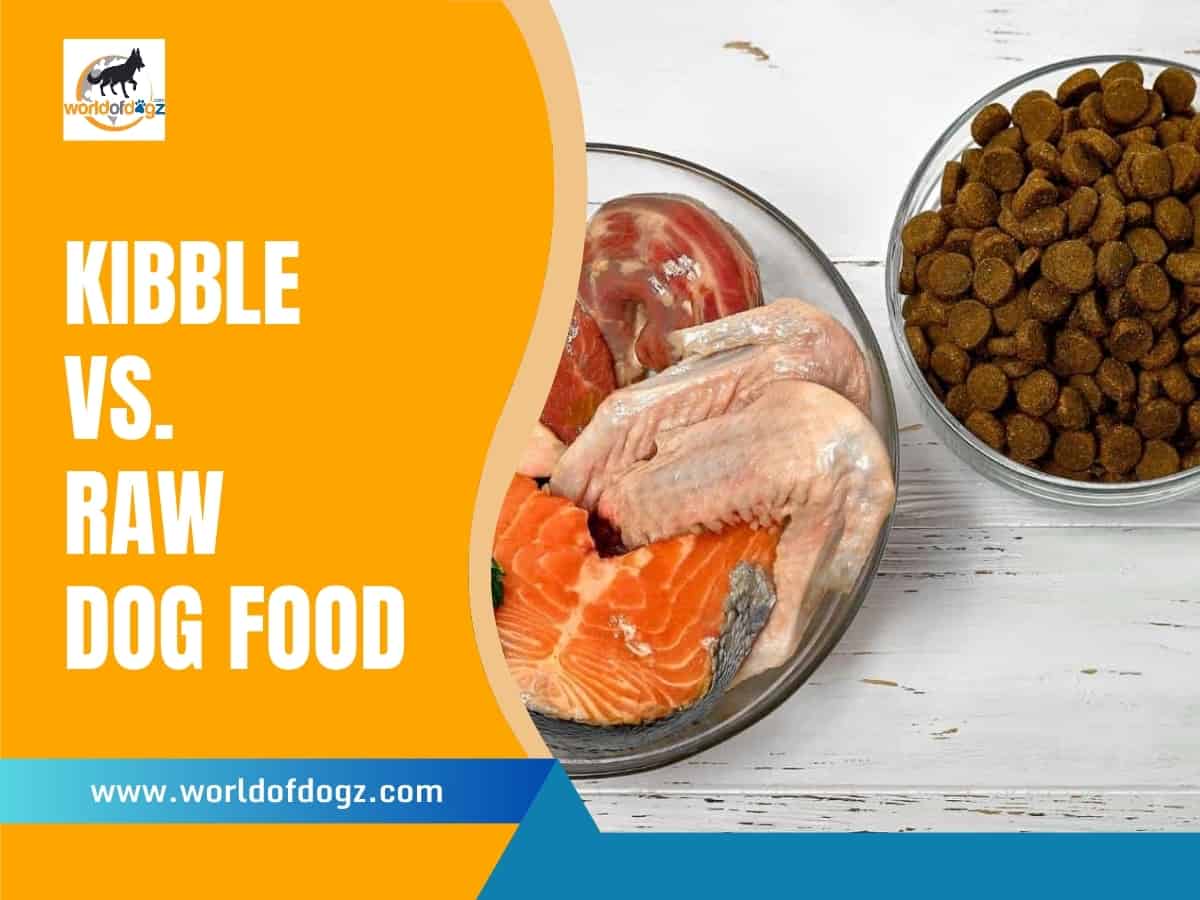
Pros and Cons of Kibble
| Pros of Kibble (vs. Raw Dog Food) | Cons of Kibble (vs. Raw Dog Food) |
|---|---|
| It is formulated to contain the nutrients your dog needs | It is cost effective |
| It is easy to store and carry | Some brands use cheap ingredients |
| Better for dental hygiene | Low moisture content |
| It is cost-effective | Some fussy eaters might reject it |
| It has a long shelf life | Top brands can be expensive, especially cold-pressed varieties |
Kibble: A Brief Overview
The word kibble originally meant “to chop coarsely.” Today, it refers to dog food that is formulated to be nutritious.
It is not chopped coarsely, but its size does match its ancestor’s meaning. Kibble generally serves canines but is often produced for specific breed sizes and life stages.
There are three main types of kibbles in terms of nutritional value: small dog kibble, medium-sized dog kibble, and large dog kibble. Each type has a puppy, young adult, and senior dog variations.
Kibble is one of the most popular commercial dog foods, but its popularity can often be limited to dog owners and may not be shared by dogs.
Depending on how fussy your dog is, you may love or hate kibble. Fortunately, kibble isn’t the only type of dog food.
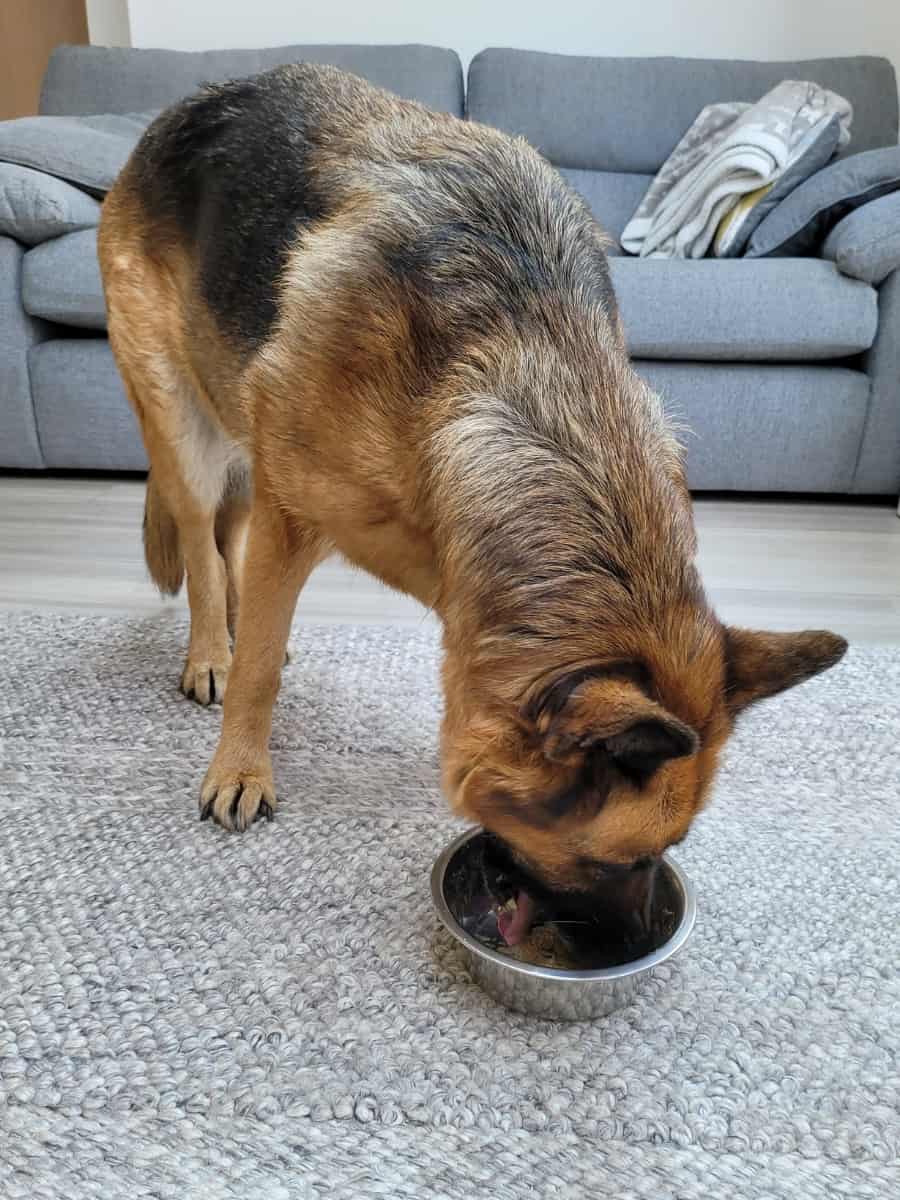
Pros of Kibble
Let’s go over some of the advantages of kibble, some of which are responsible for it being a staple in my dog Willow’s diet.
You will notice that the most perceivable benefits of kibble are for the owner. And how kibble is good for the dog can’t be perceived by him.
It Is Nutritious
Kibble often packs just the right amount of calories and macronutrients for your dog. It is, therefore, easy to feed your dog dry food without undernourishing or overfeeding him.
Since dogs can’t understand how much kibble helps their health, this benefit doesn’t translate into hunger. We will cover that in the drawbacks section.
It Is Easy To Store/Carry
This is an advantage that your dog can probably get on board with. You can carry kibble wherever you go. It isn’t terribly aromatic and doesn’t go bad at room temperature. That said, your dog might not accept it as a high-value treat.
Dry dog food has a long shelf life due to the added preservatives. Unopened kibble lasts 18 months, while opened dry dog food packaging lasts 4-6 weeks.
Better For Dental Hygiene
Kibble is great for your dog’s dental hygiene because it is not soggy. As a result, it doesn’t get lodged between his teeth at least as much as raw dog food.
Kibble can also scrub off previously stuck food, helping maintain a clean oral environment.
Cost-Effective
Kibble is at least five times cheaper than wet food; depending on the raw food you compare it to, it can be 3 to 9 times more cost-effective.
Since everything about a dog’s lifestyle centers around a sustainable routine, a diet featuring kibble can be easier to maintain from a budget perspective.
Do you want to know how much it costs to feed kibble? Head over to this article, How Much Does Dog Food Cost a Month?
Long-Lasting
Kibble has the advantage of being dry, which makes it last longer than wet dog food and raw dog food. The only comparable dog food in terms of longevity would be freeze-dried because it, too, is free of moisture.
Raw vs. Kibble? Watch This Video To Learn Which Is The Best…
Cons of Kibble
Kibble’s advantages are its convenience and sustainability, while its drawbacks are mainly its low adaptability.
I have yet to see a dog be more interested in kibble than raw or home-cooked dog food. Let’s look at the disadvantages of kibble in a little more detail.
It Contains Highly Processed Ingredients
Kibble is as processed as dog food can get. While maintaining macronutrient ratios is one of the critical factors in the kibble formula, producing pellets that can be stored for a long period requires chemical preservatives.
These can affect your dog’s health in the long run, especially if he relies on a pure kibble diet.
Cheap Ingredients
The fact that most kibble is cheap cannot coexist with the fact that high-quality ingredients are expensive. Kibble relies on feed-grade ingredients that pass the bare minimum requirements to qualify as food.
Of course, trusted kibble brands use higher quality ingredients and charge more for them. But generally, kibble makes it easier to mask cheap ingredients. In contrast, you can tell when raw food has low-quality ingredients.
Cold pressing produces complete dog food at lower temperatures, allowing the natural ingredients to retain all of their nutritional value, flavor, and aroma and the essential vitamins for digestion, growth, and good health.
Many dog owners see cold-pressed dog food as a great alternative to raw. The lower temperatures used in the cooking method retain essential nutrients, but it’s easier and more convenient to feed.
Low Moisture Content
Kibble is dry and can be unappealing to your dog for this reason. As mentioned in my post about whether dogs like their food, they have specialized tastebuds to taste water. The wetness of food is a part of their feeding experience.
Since kibble is dry, we can assume that dogs find it less appealing. You can offset this by adding water to the kibble or mixing wet food items or toppers with it. Such mixing isn’t required for wet dog food.
My dog loves a little warm water added to her dry food, turning it into a thick “gravy.” She benefits from added hydration, increased aroma, and better palatability.
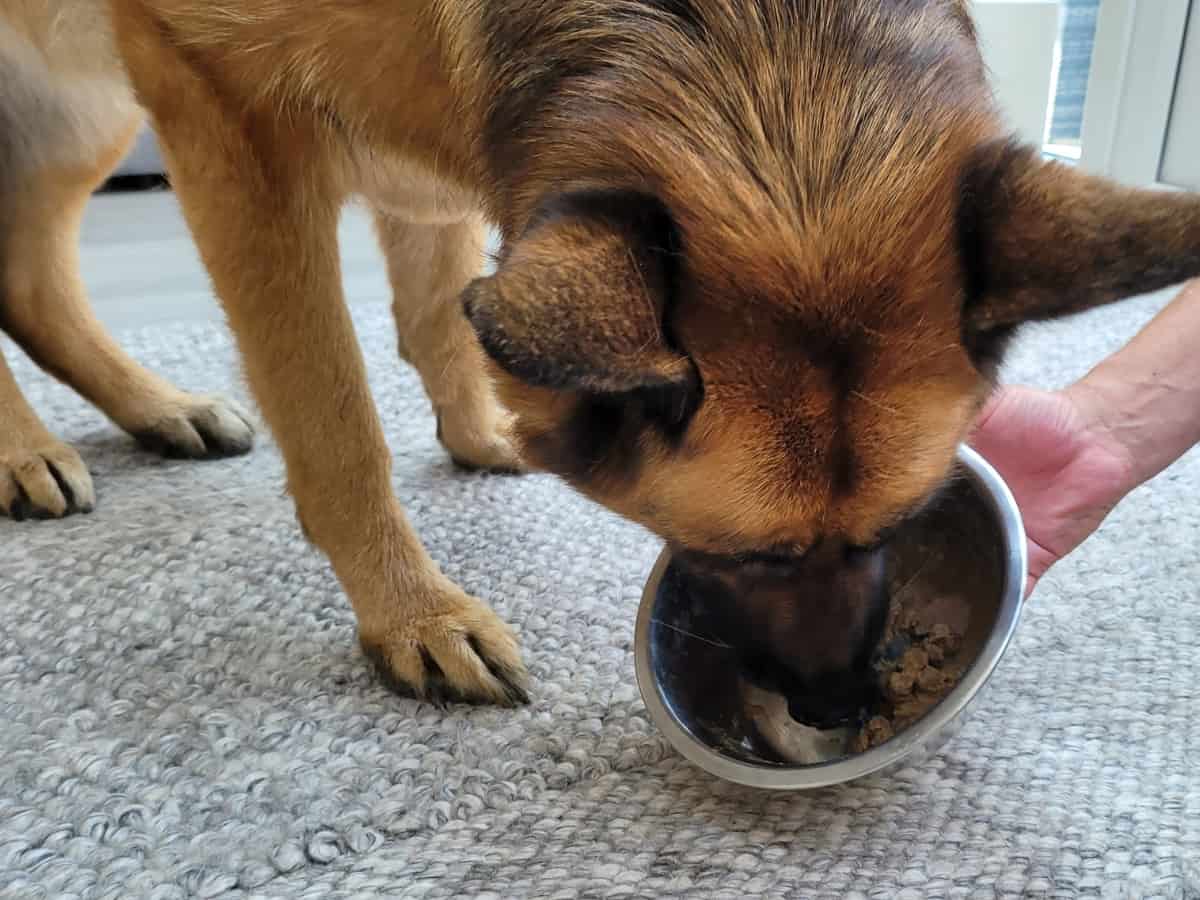
Your Dog Might Reject It
Because of low moisture content and a lack of aroma, dogs aren’t inherently interested in kibble as much as they are in other food items. In most cases, your dog might not finish a bowl full of kibble alone.
But there are instances where your dog will completely reject dry dog food. When your dog prefers being hungry over consuming kibble, you know that no advantage of kibble is worth feeding it to your dog.
Read more: Is Kibble Bad For Dogs? If So, Why?
Should I Feed Kibble To My Dog?
Now that you know the pros and cons of feeding kibble to your dog, you can see that it can be a convenient choice. However, it is not a universal choice, so other forms of dog food can exist.
You should feed your dog kibble if you can source high-quality kibble that matches your dog’s life stage and breed size and your dog accepts it.
If your dog rejects it, you might need to add a topper or opt for an alternative type of dog food.
Best practices for feeding kibble to your dog:
- Moisten the kibble – From water to wet food, you have plenty of options for adding things to the kibble to make it moist. Don’t limit your dog’s food intake to dry kibble.
- Don’t neglect vitamins and minerals – Vitamins, minerals, and fiber are pretty important alongside essential fatty acids. Ensure to include food items that contain vitamins and fiber to raise a healthy pet.
- Balance your convenience with the dog’s needs and preferences – A pure kibble diet is one of the most convenient ones for dog owners. But as covered earlier, your dog might prefer wet food. Make sure that you balance what your dog needs with what he wants, or he will reject kibble.
- Don’t force particular kibble products on your dog – Don’t get so strict about the nutrition that your dog’s diet becomes tyrannical. Try to make his eating experience as enjoyable as you can. The more he can enjoy his food, the less effort you need to make him have it.
Pros and Cons of Raw Dog Food
| Pros of Raw Dog Food (vs. Kibble) | Cons of Raw Dog Food (vs. Kibble) |
|---|---|
| It is appetizing | It is hard to store |
| It contains high levels of protein | It can get contaminated easily |
| Can be more holistic | Difficult to maintain the correct nutrients (unless you seek expert advice or buy frozen) |
| It promotes superior joint and bone health | Can be expensive |
| Reduces poop volume and odor | Preparation of food is time-consuming |
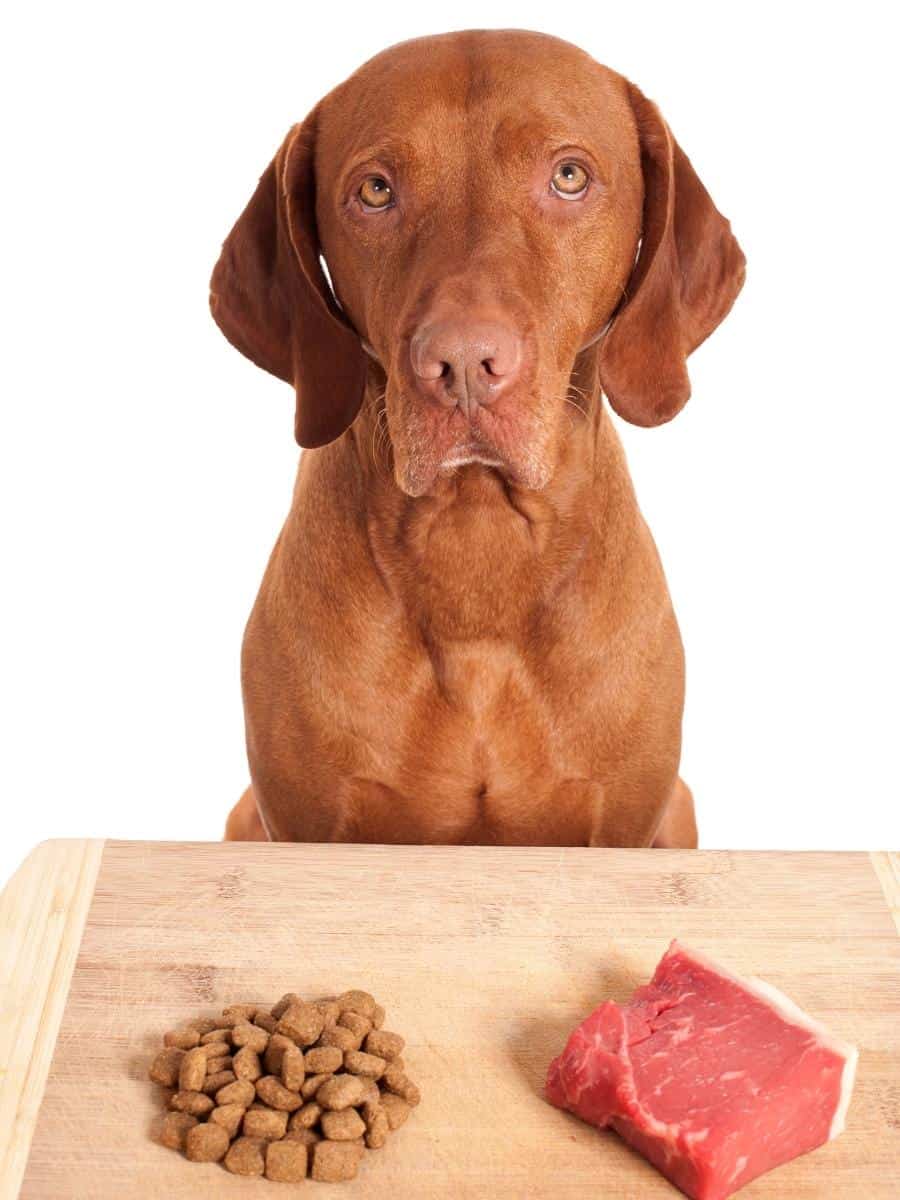
Raw Dog Food: A Brief Overview
A raw diet is, as the name suggests, a diet made up of raw food. Since dogs have a carnivorous bias, they are more than happy to consume meat, which is a significant part of the raw dog diet.
You need to pay attention to two similar-sounding terms regarding dog food and raw ingredients.
“Raw dog diet” and “raw dog food” can seem interchangeable but vary significantly.
Raw dog food refers to store-bought or homemade raw uncooked items that can be consumed raw. It can also refer to freeze-dried dog food, which is raw food with moisture extracted from it for easier storage.
A raw dog diet consists of 100% raw ingredients. You can mix raw dog food with kibble or wet dog food. But you cannot mix anything processed or cooked with raw dog food if your dog is on a raw diet.
Since the pros and cons of kibble were addressed from a kibble-only standpoint, the pros and cons of raw dog food will also be viewed from a raw-only perspective.
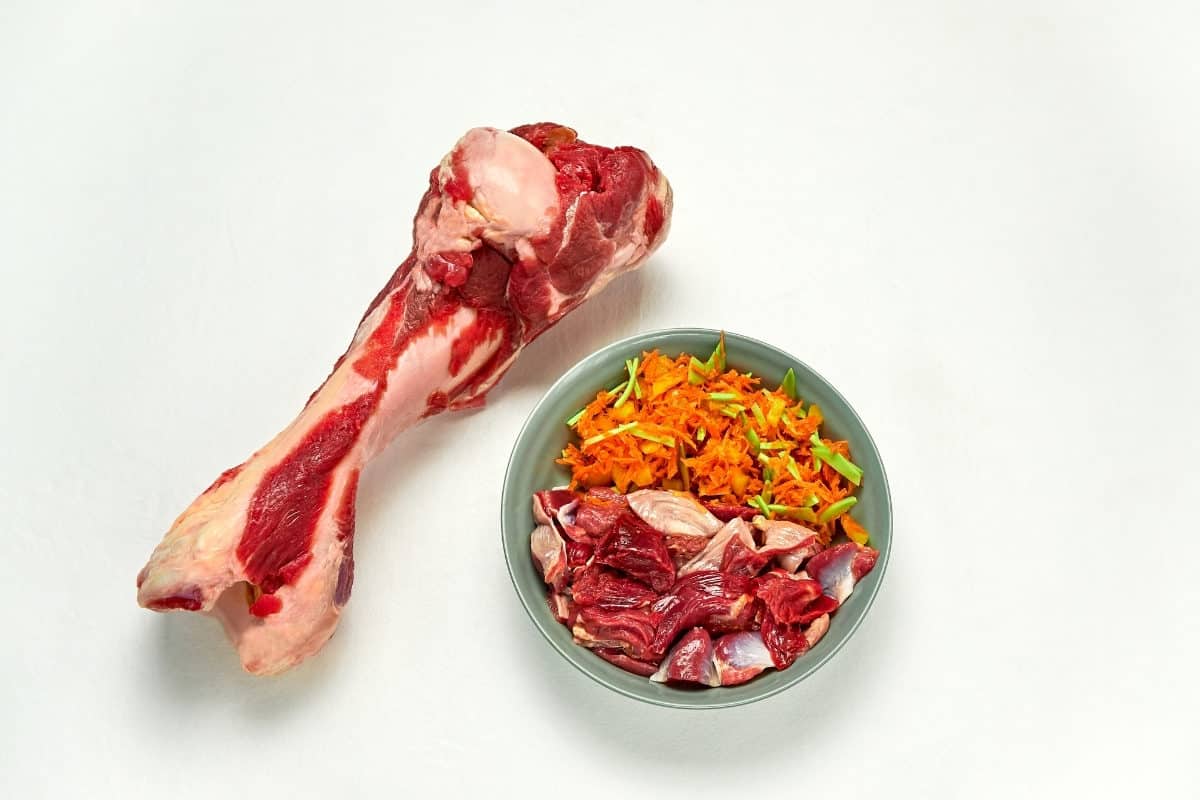
Pros of Raw Dog Diet
Raw dog food is said to have many benefits, like promoting healthy skin and a shiny coat.
However, since these benefits aren’t backed by anything other than owners’ anecdotes and claims, we will not include them in the pros of a raw dog diet. Instead, we will go by what is verifiable. Here are the main pros of a raw dog diet.
It Is Appetizing
Since most raw dog food contains meat, and dogs have a carnivorous bias despite being omnivores, a raw dog food diet is very appetizing.
Dogs rarely reject a diet featuring meat, and you don’t have difficulty getting them to accept food. In fact, they end up begging you for more.
It Contains High Levels Of Protein
Once again, this benefit stems from the presence of meat in a dog’s diet. The more meat in the dog food, the better for your dog’s health.
This is true, especially if your dog is big. Bigger dogs need more protein to maintain their muscle mass.
The protein content helps build lean muscle, benefits new cell generation, and builds immunity. Having said that, it is worth remembering that dogs also need other macronutrients besides protein.
It Can Be More Holistic
Fortunately, raw food features fats and carbs as well. You can add veggies and yogurt to the raw dog food to promote better gut health and incorporate vitamins into the diet.
A raw dog diet assumes a more involved owner, increasing the odds of the diet being more holistic.
It Promotes Superior Joint And Bone Health
Regardless of your dog’s diet involvement, if you feed him raw food, you automate his joint and bone health. Meat intake has a direct correlation with joint and bone health in dogs.
Technically, raw food can consist of just vegetables, so this benefit is contingent on the amount of meat in the dog’s diet.
It Reduces Poop Volume and Odor
Raw dog food results in less smelly poop. This might be because of no preservatives and closer-to-nature ingredients in the dog’s diet.
You can tell the difference between a dog who consumes raw food and a dog who eats kibble by simply looking at the stool volume and consistency.
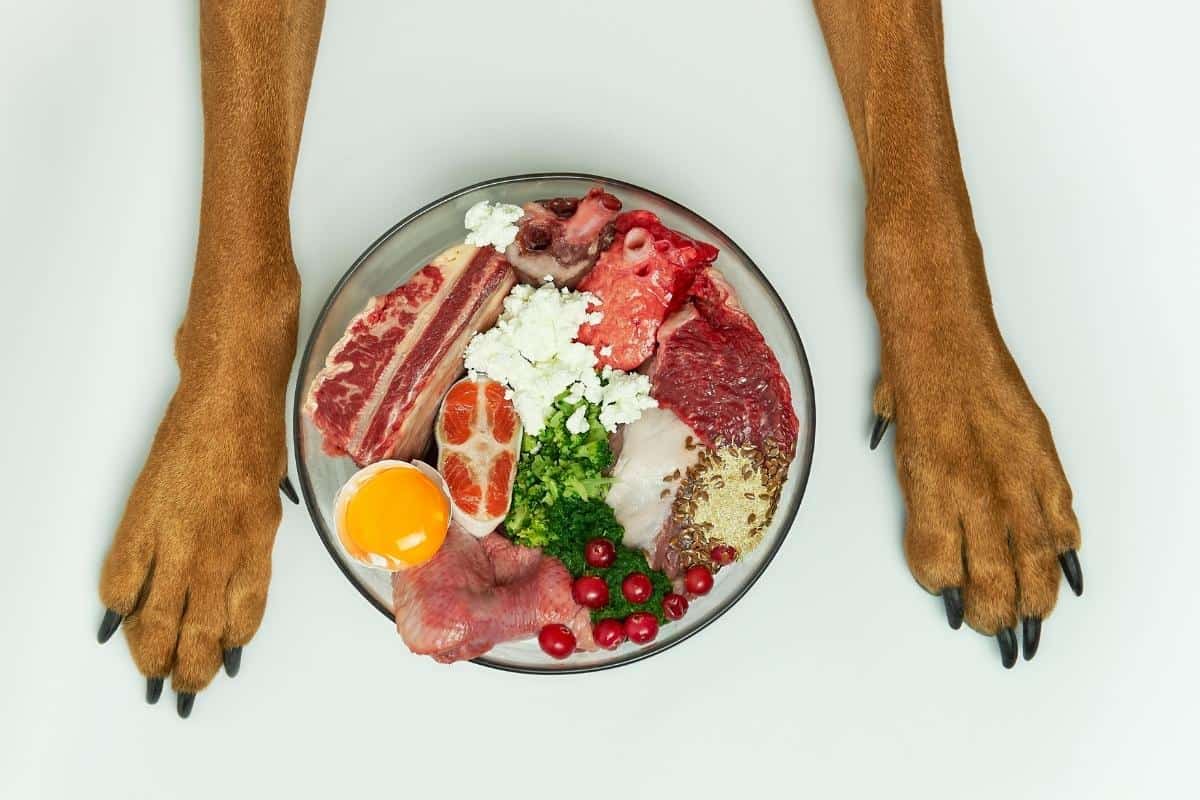
Cons of Raw Dog Food
Raw dog food is getting pretty popular. However, it doesn’t have most of the dog food market share simply because it is limited in multiple ways.
In this section, I will review some of the most common disadvantages of feeding your dog an exclusively raw diet.
It Is Hard To Store
The first problem with raw dog food is that it is a hassle to store. Human food is also a hassle to store, but we can refrigerate and microwave food whenever it is storing or feeding time, respectively.
Storing dog food can be complicated when you cannot cook it or heat it up.
It Can Get Contaminated Easily
Continuing on the theme of storage, the meat content of the raw diet is as vulnerable as any edible item can ever get. It is one of the most vulnerable types of food when it is not cooked, and almost any bacteria can survive.
This latest study review on raw diets concerning microbiological hazards highlights that the prevalence of potentially serious germs is considerably higher in raw pet food than in heat‐treated food.
Also, the CDC does not advise a raw food diet for dogs due to health concerns around pet food safety, and this is justified, according to the above study.
However, it is accepted that more research is needed on the health risks and nutritional benefits of raw feeding.
Your Dog Can Become Overweight (Or Underweight)
Another problem with raw dog food is that it is hard to pinpoint its nutritional information. The only exception seems to be in freeze-dried or raw frozen food.
Packages of freeze-dried and raw frozen dog food can be categorized by dog breed and life stage. But if you’re using raw meat and dairy to feed your dog, even your most accurate guess is still a guess.
It Is Expensive To Maintain
Finally, the greatest disadvantage of a raw dog food diet is also the one that can limit anything from becoming a global phenomenon: it is too expensive.
Depending on the ingredients you use for your raw dog food recipes, you might spend 3 to 5 times more per month by choosing it over kibble.
Do you want to know how much it costs to feed your dog a raw diet? Check out this article, The Cost To Feed Raw Dog Food (The True Price!).
Preparation of Raw Food is Time Consuming
Feeding your bestie a raw food diet takes time and preparation. As germs like listeria and salmonella bacteria are a risk, you must take food safety precautions to prevent your dog or your family from becoming sick.
When handling raw pet food, you must properly wash your hands and any surrounding surfaces.
Preparing, sanitizing, and researching proper raw food feeding takes a long time.
Home-prepared raw food might not be for you if you don’t have the time to become a part-time dog nutritionist and maintain your dog’s area like a commercial kitchen!
Mixing Kibble With Raw Dog Food (A Compromise!)
If you’re still undecided about whether to feed kibble or raw, the best alternative option is to feed the hybrid diet – a mix of dry dog food and raw.
For example, add some pieces of lean chicken or meat with dog-friendly vegetables to your dog’s dry feed. This can make a perfectly digestible and healthy meal.
However, when combining the two diets, if you’ve only fed dry food to your dog, you must slowly add small portions of raw food when transitioning to a kibble and raw hybrid diet.
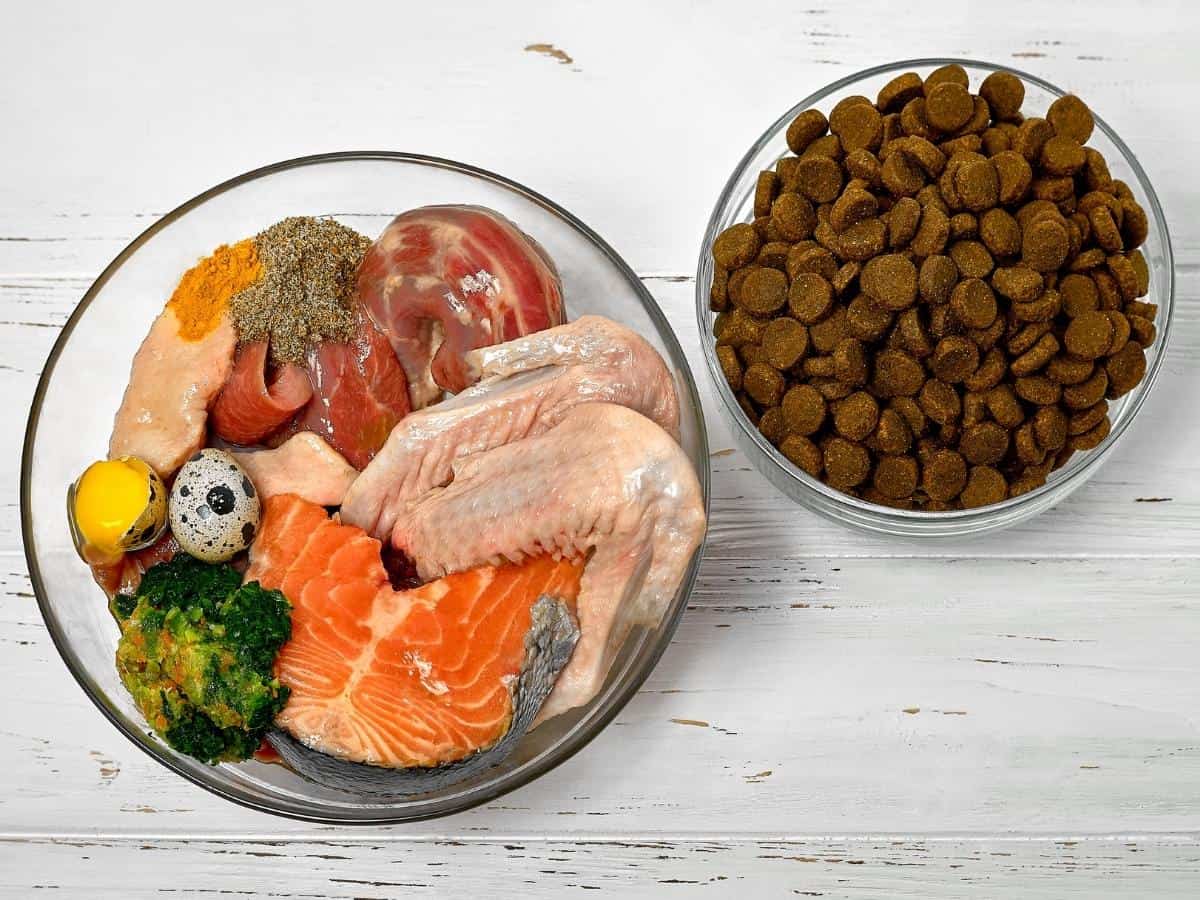
Final Thoughts
In a kibble vs. raw dog food discussion, kibble is inexpensive and easy to get right with minimal effort. Raw dog food is more appetizing and holistic but requires a lot of hygiene care and significantly higher investment.
A mix of the two can be a mid-way solution, but ultimately, your personal context, your dog’s needs, and his preferences determine which one is best for you.
And if you’re not entirely convinced about raw feeding, you might want to check out my post on the pros and cons of dry dog food vs. home-cooked dog food, Kibble vs. Homemade Dog Food (Which is Better?)
Related Posts You May Like:





